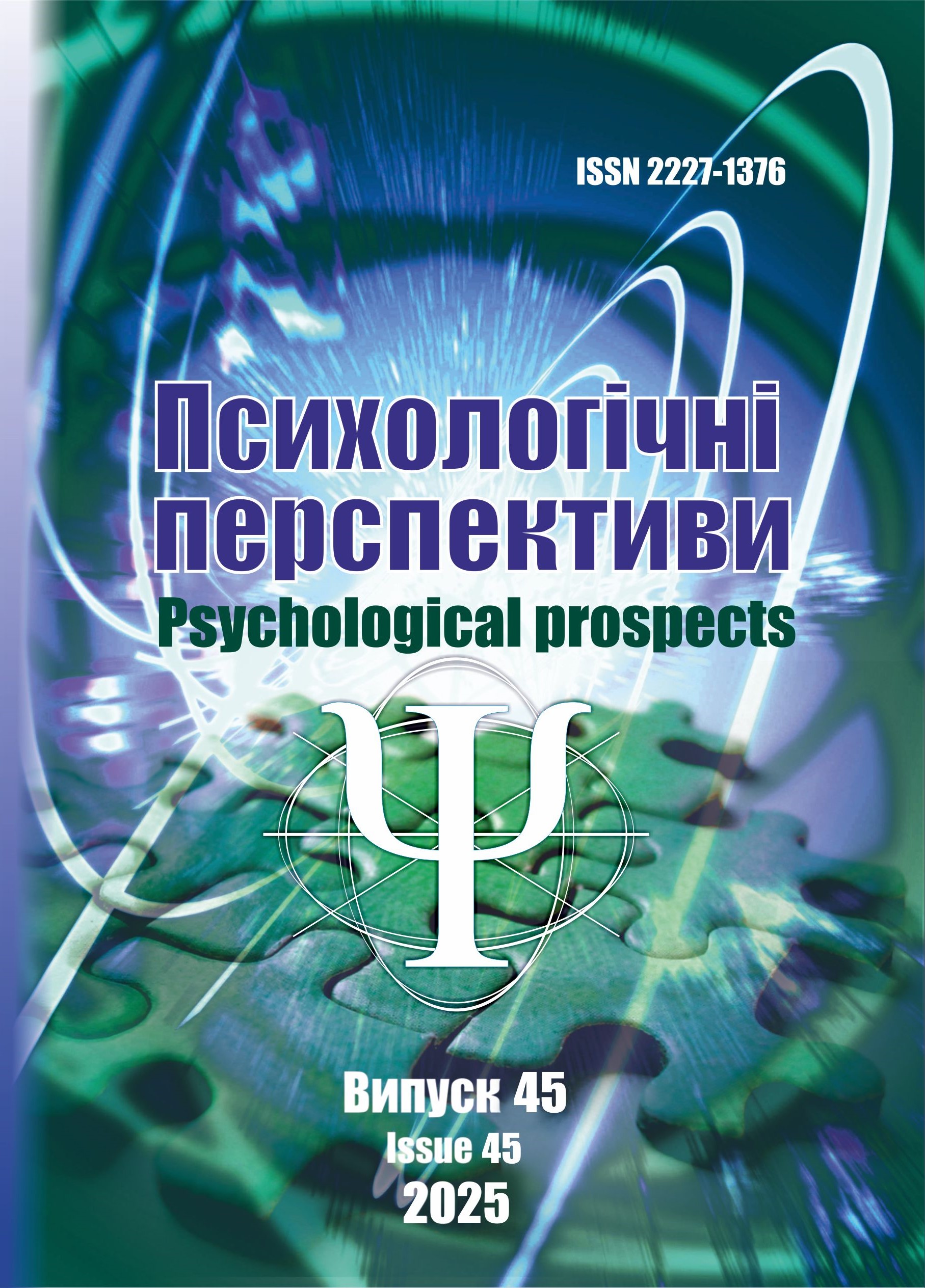Dance-movement therapy as psychological support for women during the war
DOI:
https://doi.org/10.29038/2227-1376-2025-45-milKeywords:
dance therapy, psycho-emotional state, stress, anxiety, middle ageAbstract
Purpose. Ttheoretical justification and experimental determination of the impact of dance-movement therapy (DMT) on the psycho-emotional state of middle-aged women during the war. The study is aimed at studying the effectiveness of DMT in reducing stress, anxiety and improving emotional stability in this age group, as well as developing practical recommendations for the use of DMT.
Methods. The study was conducted at the Center for Psychological Support and Development. 60 middle-aged women (from 35 to 50 years old) participated in the study: 30 women - experimental group, 30 women - control group. The following psychodiagnostic methods were used in the study: Methodology "Self-assessment of mental states" (according to G. Eysenck), DEPS Depression Scale, Beck Anxiety Scale. Women in the experimental group underwent an 8-week dance-movement therapy course, during which regular assessments of their psycho-emotional state were conducted. Women in the control group underwent only diagnostic work, no correction was performed.
Results. There was a decrease in the indicators of anxiety, aggressiveness, frustration, and depression in women in the experimental group. The conducted one-factor analysis of variance confirmed the presence of statistically significant differences between the groups of respondents and the positive effect of the dance-movement therapy course on the manifestations of depression, aggressiveness, and frustration. Respondents in the control group, who received only social assistance during this time, did not demonstrate significant changes in their psycho-emotional state.
Conclusions. Dance-movement therapy had a positive effect on reducing the level of anxiety, depression, and aggression in women with average indicators of these states. No positive effect of the implemented dance-movement therapy program on the rigidity of the respondents was recorded. Patients with high levels of anxiety and depression did not experience significant improvement under the influence of dance-movement therapy. The study confirms the effectiveness of DMT in comprehensive socio-psychological support of the mental state of women during the war, but does not have proven effectiveness in the therapy of high levels of anxiety and depression.
References
1. Zabuta, I., Kolohryvova, E., Yehorenkova, K. (2022). Knyha Tanho-spovid: 12 khvylyn shchyrosti [Book Tango-confession: 12 minutes of sincerity]. Kyiv: Vyd. Rostyslava Burlaky.
2. Kolpakchy, O. (2018). Art-terapiia [Art Therapy]. Kyiv. [in Ukrainian].
3. Miliutina, K.L. Holota, K., Tereshchenko, K. (2022). Vplyv tantsiu na psykhoemotsiinyi stan liudei pid chas viiny [The influence of dance on the psycho-emotional state of people during the war]. Theoretical foundations of pedagogy and education: collective monograph. (p.411-420). Boston : Primedia eLaunch DOI: https://doi.org/10.46299/ISG.2022.MONO.PED.2.8.1
4. Miliutina, K.L., Yatsenko, A.O. (2021). Uiavlennia pro vlasne tilo v osib, shcho zaimaiutsia sotsialnymy tantsiamy [Body image of people engaged in social dancing]. Habitus, 29, 132-136. https://doi.org/10.32843/2663-5208.2021.29.22 [in Ukrainian]. DOI: https://doi.org/10.32843/2663-5208.2021.29.22
5. Nakaz Ministerstva okhorony zdorovia Ukrainy vid 13 hrudnia 2023 roku N2118, Zareiestrovano v Min. Yust. Ukrainy 25 sichnia 2024 r. za N 129/41474 [Order of the Ministry of Health of Ukraine dated December 13, 2023 N2118, Registered in the Ministry of Justice of Ukraine on January 25, 2024 under N 129/41474]. [in Ukrainian].
6. Chettiar, C., & Mascarenhas, C. (2024). A dance movement therapy intervention with adolescent victims of trauma in Mumbai. Body, Movement and Dance in Psychotherapy, 20(1), 40–55. https://doi.org/10.1080/17432979.2024.2411958 DOI: https://doi.org/10.1080/17432979.2024.2411958
7. EADMT Dance Movement Therapy. https://eadmt.com/
8. Krantz, A. M., & Pennebaker, J. W. (2007). Expressive dance, writing, trauma, and health: When words have a body. In I. A. Serlin, J. Sonke-Henderson, R. Brandman, & J. Graham-Pole (Eds.), Whole person healthcare Vol. 3. The arts and health (pp. 201–229). Praeger Publishers.
9. Pandya, S. P. (2023). Dance movement therapy, yoga, and older adults with Parkinson’s disease: balance confidence, anxieties, and wellbeing. Body, Movement and Dance in Psychotherapy, 19(2), 157–173. https://doi.org/10.1080/17432979.2023.2242444 DOI: https://doi.org/10.1080/17432979.2023.2242444
10. Serlin, I. (2022). Dance movement therapy: crossing cultural and professional bridges. Body, Movement and Dance in Psychotherapy, 18(1), 75–85. https://doi.org/10.1080/17432979.2021.2021988 DOI: https://doi.org/10.1080/17432979.2021.2021988
11. Serrano-Guzmán, M., Valenza-Peña, C. M., Serrano-Guzmán, C., Aguilar-Ferrándiz, E., Valenza-Demet, G., & Villaverde-Gutiérrez, C. (2016). Effects of a dance therapy programme on quality of life, sleep and blood pressure in middle-aged women: A randomised controlled trial. Medicina clinica, 147(8), 334–339. https://doi.org/10.1016/j.medcli.2016.06.030 DOI: https://doi.org/10.1016/j.medcle.2016.11.016
12. Takahashi, H., & Kato, T. (2022). Effectiveness of dance/movement therapy in individuals with intellectual disability: a systematic review. Body, Movement and Dance in Psychotherapy, 18(1), 56–74. https://doi.org/10.1080/17432979.2022.2101528 DOI: https://doi.org/10.1080/17432979.2022.2101528
13. Tolfree, D. (1996). Different Approaches to Assisting Children Who Are Psychologically Affected by War or Displacement. Stockholm: Radda Barnen.
14. Veid, N., Pollari, A., Hyvönen, K., & Pylvänäinen, P. (2022). Dance movement therapy group improves social functioning and increases positive embodied experiences in social situations. Body, Movement and Dance in Psychotherapy, 18(3), 201–217. https://doi.org/10.1080/17432979.2022.2122563 DOI: https://doi.org/10.1080/17432979.2022.2122563
15. Yamada, M., & Kawano, T. (2023). Dance/movement therapy pedagogy with Japanese psychology graduate students: facing ‘haji.’ Body, Movement and Dance in Psychotherapy, 19(2), 127–141. https://doi.org/10.1080/17432979.2023.2245431 DOI: https://doi.org/10.1080/17432979.2023.2245431
Downloads
Published
Issue
Section
License
Copyright (c) 2025 Kateryna Milyutina, Anna Bybka

This work is licensed under a Creative Commons Attribution-NonCommercial 4.0 International License.






